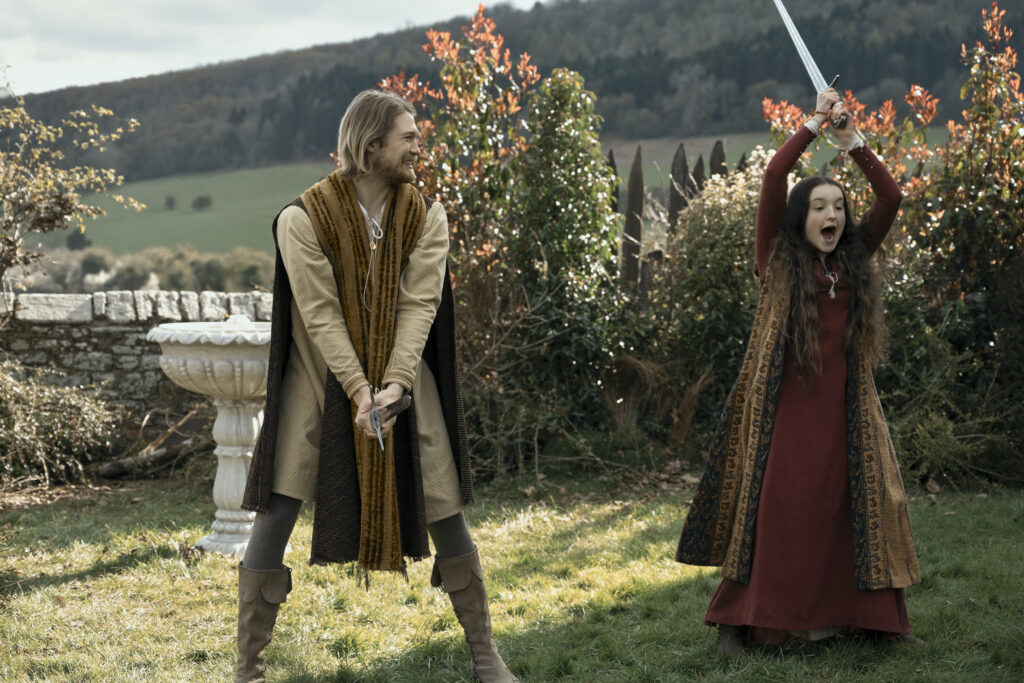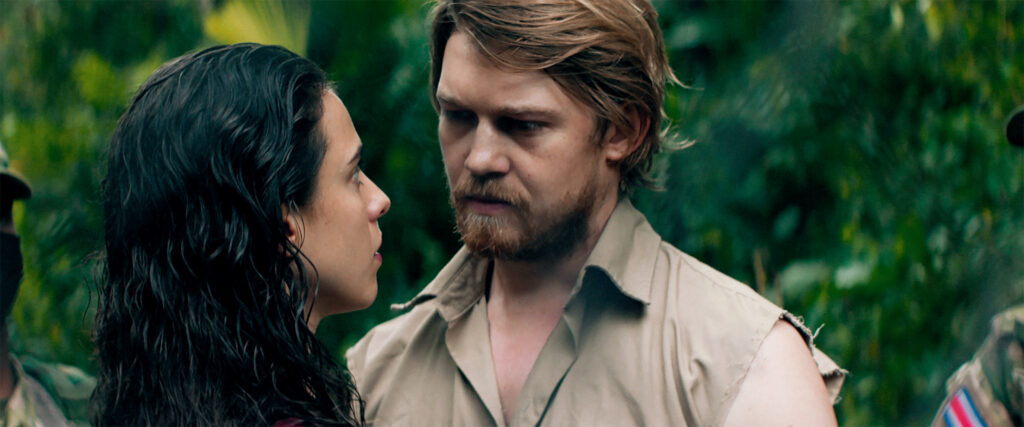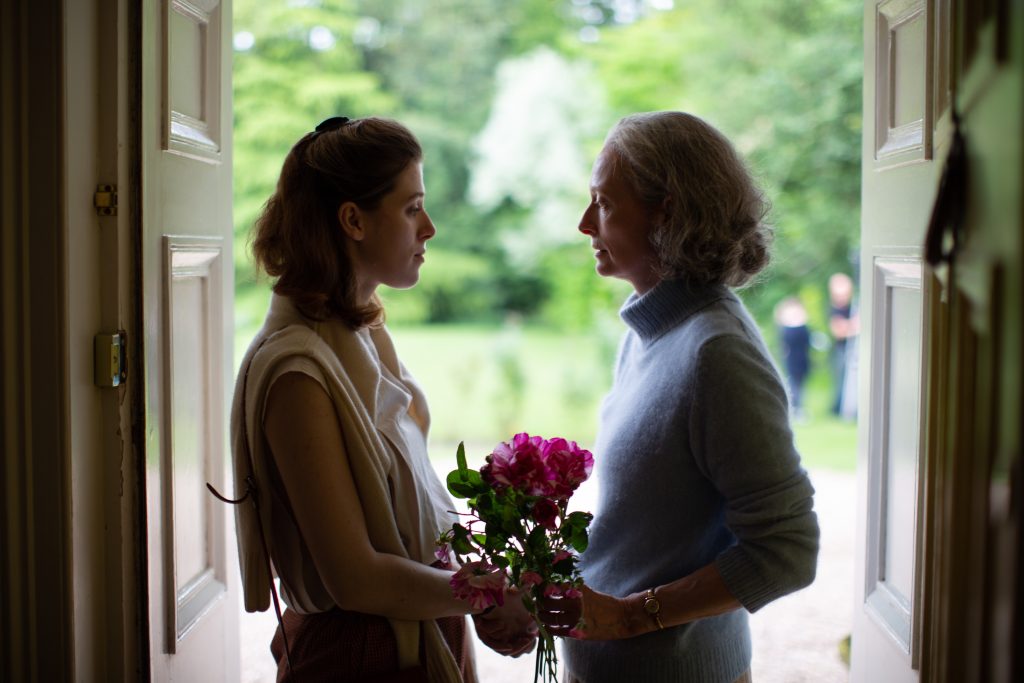June 20, 2024
by Carla Hay

Directed by Yorgos Lanthimos
Culture Representation: Taking place in various parts of Louisiana, the comedy/drama film “Kinds of Kindness” features a predominantly white cast of characters (with a few African Americans and Asians) representing the working-class, middle-class and wealthy.
Culture Clash: Various people seek satisfaction in their lives but experience conflicts in this offbeat, three-story anthology.
Culture Audience: “Kinds of Kindness” will appeal primarily to people who are fans of the movie’s headliners, filmmaker Yorgos Lanthimos and movies that are often strange but are well-acted.

It’s weird and not always wonderful, but “Kinds of Kindness” has committed performances from the cast members in this unpredictable anthology film. This acerbic comedy/drama cuttingly explores the dark sides of power, control and manipulation. Several scenes in “Kinds of Kindness” are deliberately off-putting and intended to make people squirm with discomfort.
For example, there’s a scene where a woman is drugged without her knowledge and consent, and then she is raped while she’s unconscious. (The sexual assault is not shown in graphic detail.) There’s another scene that shows animal cruelty. (A disclaimer in the movie’s end credits says that no animals were harmed while making the film.) In other words, “Kinds of Kindness” is not a family-oriented film that’s supposed to have mass appeal.
Directed by Yorgos Lanthimos (who co-wrote “Kinds of Kindness” with Efthimis Filippou), “Kinds of Kindness” had its world premiere at the 2024 Cannes Film Festival, where “Kinds of Kindness” co-star Jesse Plemons won the award for Best Actor. This anthology movie is told as three different stories, all taking place in Louisiana, where “Kinds of Kindness” was filmed on location. Lanthimos is known for making offbeat movies about people doing very unpleasant things to each other. Most of his movies also depict polyamory and/or sexual fluidity. “Kinds of Kindness” is more extreme and less straightforward than Lanthimos’ Oscar-winning films “The Favourite” and “Poor Things.” Some cast members from “The Favourite” and “Poor Things” are also in “Kinds of Kindness.”
In “Kinds of Kindness,” the three stories have these titles, shown in this order: “The Death of R.M.F.,” “R.M.F. Is Flying” and “R.M.F. Eats a Sandwich.” (R.M.F. is a mysterious character played by Yorgos Stefanakos in all three stories.) All three stories feature the other main actors portraying different characters in each story. Emma Stone, Plemons, Willem Dafoe, Margaret Qualley, Hong Chau, Joe Alwyn and Mamoudou Athie are the rotating star cast members in each story. Stone and Plemons get the most screen time. Hunter Schafer has a small role in “R.M.F. Eats a Sandwich.”
Each story takes its time to reveal the motives of the central protagonists. Keeping the viewers guessing in this way has benefits and limitations. Viewers who have short attention spans will quickly grow tired of “Kinds of Kindness” because of all the guessing games that the movie has in revealing bits and pieces of each story. Many times, viewers will be asking themselves, “Where is this story going?” If you dislike how the first story plays out, then chances are you won’t like the rest of the movie either.
“The Death of R.M.F.”

In “The Death of R.M.F.,” Robert Fletcher (played by Plemons) and his wife Sarah (played by Chau) are a seemingly regular middle-class couple. Sarah and Robert have no children, but they have been trying to start a family. Sarah has gotten pregnant several times but lost all of the pregnancies.
Robert works for a company in an unnamed industry. It’s an office job where Robert is expected to wear business attire. Robert’s boss is Raymond (played by Dafoe), who is a demanding tyrant. Robert and Raymond have been in each other’s lives for about 10 years.
It soon becomes apparent that Raymond wants complete control over certain people in his life. For example, Raymond dictates what Robert and Sarah can eat and when the couple can have sex. Raymond also tells Robert that Robert needs to gain a few more pounds. Raymond expects Robert to confirm every day that Robert has followed Raymond’s orders. Robert willingly complies.
However, there’s one demand from Raymond that Robert has a problem carrying out: Raymond has ordered Robert to kill someone by crashing Robert’s car into the other person’s car. Raymond insists that this car crash has been arranged by a suicidal person whose car will be hit by Robert’s car. Robert is supposed to get a description of the car and the crash victim in advance.
Robert is very reluctant to follow this order from Raymond. Near the beginning of the movie, R.M.F. is shown as someone who’s in another car that Robert crashes into with his car. The fate of R.M.F. is shown in this story. Meanwhile, Raymond’s willing accomplice in these bizarre suicide arrangements is his lover Vivian (played by Qualley), who has been put in charge of meeting with the future car crash victims and asking them to pose for photos that she sends to Raymond for his approval.
It’s soon revealed that Robert is also sexually involved with Raymond, who expects to have complete control over Robert, Vivian and other people. Raymond sometimes gives rare collectibles to manipulate people into thinking that he likes them. In the beginning of the story, Raymond has gifted to Robert and Sarah a tennis racket that was smashed by John McEnroe in 1984.
Alwyn has a cameo as a collectibles appraiser who meets with Raymond. Athie is briefly seen in this story as a character named Will, who also works for Raymond. Stone has the role of a lonely bachelorette named Rita, whom Robert asks on a date after Robert sees that Raymond is also dating Rita.
“R.M.F. Is Flying”

In “R.M.F. Is Flying,” Daniel (played by Plemons) and Neil (played by Athie) are best friends and police officers who work together. Daniel and his wife Liz (played by Stone) are very close to Neil and his wife Martha (played by Qualley) and spend a lot of time at each other’s houses. The two couples are so close, it’s eventually revealed that they are swingers who have foursome orgies with each other that they record on video.
In the beginning of this story, Liz (who is a marine biologist explorer) has been missing during a deep-sea exploration trip. However, Liz has been found on a remote island and has been rescued by helicopter. When she arrives home after a brief stay in a hospital, Daniel notices that Liz has a hard time putting on her shoes, because her feet seem slightly bigger than her shoes. Liz says her feet must be swollen.
Other things happen (as shown in the story) that convince Daniel that the person who was rescued and claims to be his wife Liz is an imposter. Is Daniel imagining things or is he correct? Liz’s father George (played by Dafoe) disapproves of how Daniel has been acting cold and distant to Liz, ever since the rescue. Chao has the role of George’s supportive wife Sharon. Alywn appears in the movie in a brief role as a defiant and intoxicated passenger in a car that gets pulled over by Daniel for reckless driving.
“R.M.F. Eats a Sandwich”

In “R.M.F. Eats a Sandwich,” Emily (played by Stone) and Andrew (played by Plemons) are on an intense search for a woman who saved Emily’s life when Emily almost drowned in a swimming pool. At first, Emily and Andrew seem like they’re a couple. But it’s eventually revealed they’re in some kind of polyamorous sex cult led by a domineering guru named Omi (played by Dafoe), who decides which people in the cult will have sex with Omi and when. A mother named AKA (played by Chau) has a certain “tastemaker” role in the cult.
Emily is literally a hard-driving person: She speeds, careens and skids around in a dark purple Dodge Challenger, as if she’s in a demolition derby race. Emily is rude and impatient in her obsessive search. The reason for the search has to do with special powers that she thinks her rescuer has.
Qualley portrays identical twins Rebecca and Ruth in this story. Schafer has a small role as a woman named Anna, who is examined by Emily in a hospital and is quickly rejected as not being the woman whom Emily is seeking. Alwyn portrays Joseph, Emily’s estranged husband, who has custody of their unnamed daughter (played by Merah Benoit), who’s about 7 or 8 years old. Athie has the role of an unnamed morgue nurse.
Of these three stories, “R.M.F. Eats a Sandwich” is the most memorable and the most disturbing. It’s also sure to be the most divisive part of “Kinds of Kindness” because of the way it depicts spiritual beliefs and sex in the context of a cult. The main reason to keep watching is to find out what happens in the story’s mystery.
Because “Kinds of Kindness” has two stories in this movie where Dafoe portrays a leader who controls other people’s sex lives, “Kinds of Kindness” seems to be repeating itself in this way, which is to the movie’s detriment. Some of the movie’s bizarre scenes can be amusing, while other weirdness is just plain irritating and serves no other purpose but to show something weird. The cinematography (by Robbie Ryan) gives “Kinds of Kindness” a compelling modern noir tone.
The cast members’ performances make much of the movie more interesting. Stone excels in portraying three very different characters. The other cast members also capably handle their roles. Plemons’ three characters (Robert, Daniel and Andrew) all have loss of control as a major part of their stories, so his “Kinds of Kindness” characters are not as varied as Stone’s characters in this movie.
Viewers of “Kinds of Kindness” should not go into this movie expecting to see charming characters who are easy to like. The movie goes out of its way to have characters who are unlikable or are sometimes difficult to watch. “Kinds of Kindness” is like sushi smothered in wasabi. Many people won’t be able to tolerate the parts that sting, but there are other parts that go down easier and have more substance if people are curious to see how everything ends.
Searchlight Pictures will release “Kinds of Kindness” in select U.S. cinemas on June 21, 2024.






